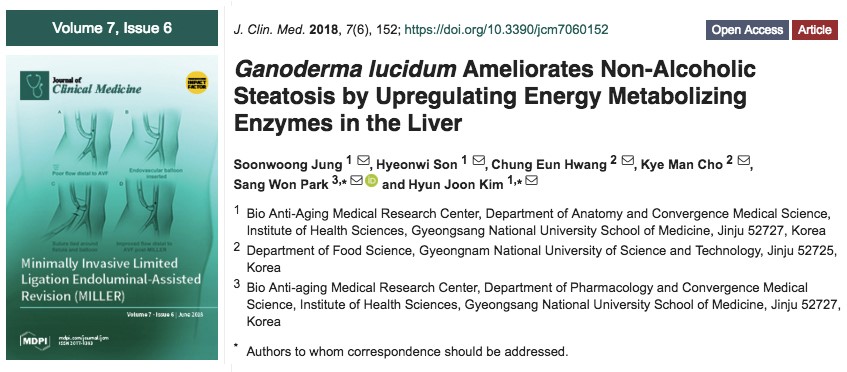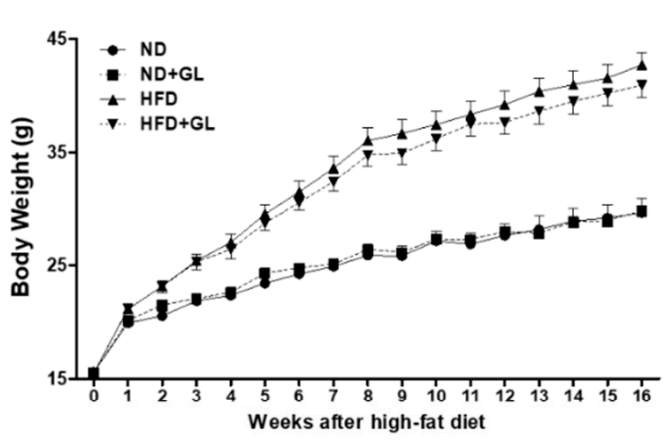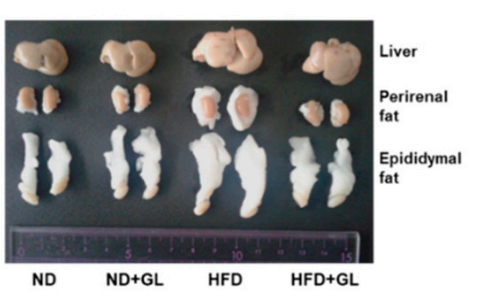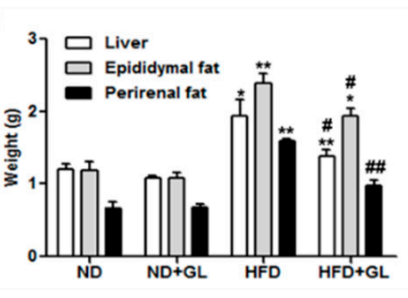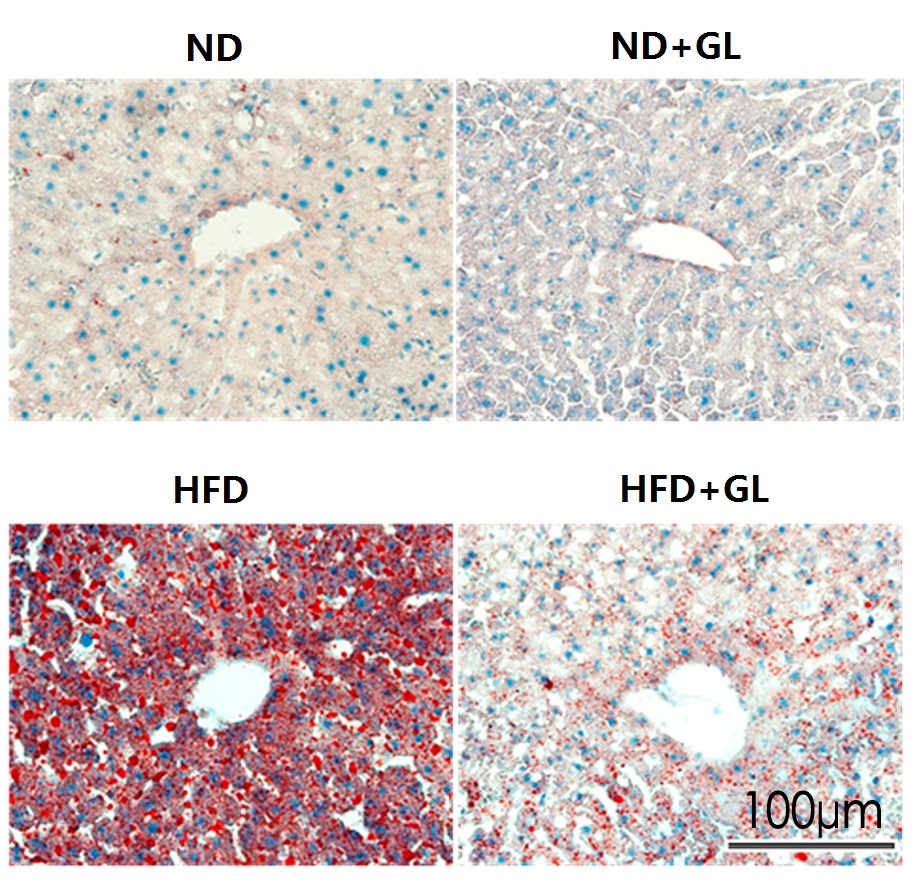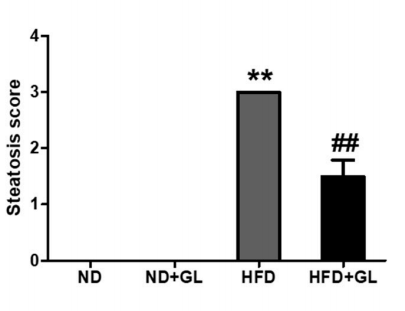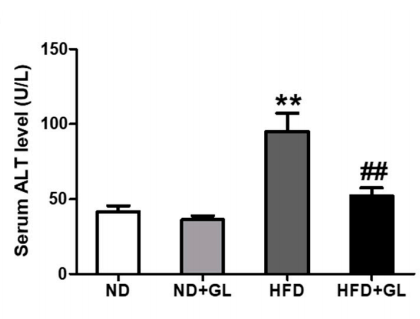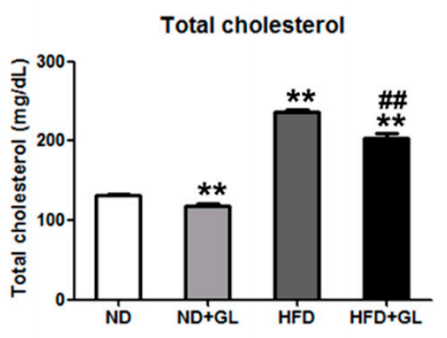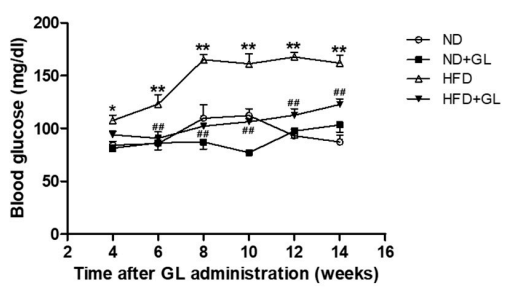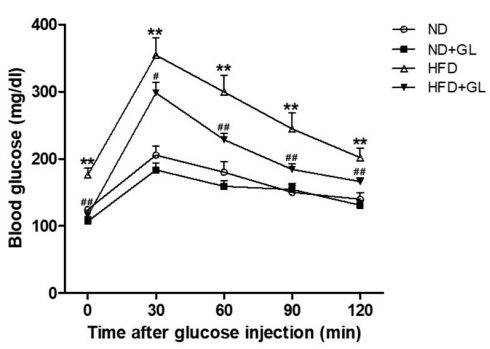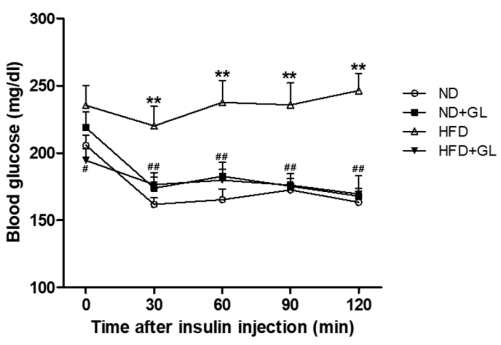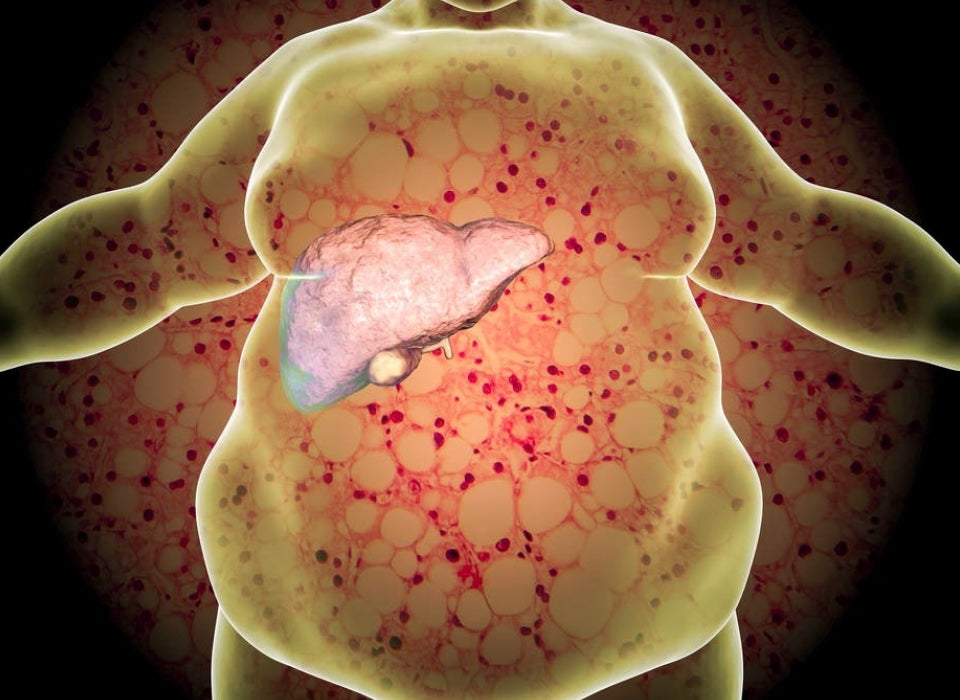
GANODERMA LUCIDUM AMELIORATES NON-ALCOHOLIC STEATOSIS
Gyeongsang National University School of Medicine in South Korea published a paper in the Journal of Clinical Medicine in June 2018 stating that Ganoderma lucidum can reduce liver fat accumulation caused by a high-fat diet, but related animal experiments also found that that mice fattened by a high-fat diet will also have less serious blood glucose and blood lipid problems due to the intervention of Ganoderma lucidum.
The experimental mice were divided into four groups: normal diet (ND), normal diet (ND) + Ganoderma lucidum (GL), high-fat diet (HFD), high-fat diet (HFD) + Ganoderma lucidum (GL). In the feed of the normal diet group, fat accounted for 6% of the total calories; in the feed of the high-fat diet, fat accounted for 45% of the total calories, which was 7.5 times of the former. The Ganoderma lucidum fed to mice is actually an ethanol extract of the fruiting body of Ganoderma lucidum. The researchers fed the mice at a dose of 50 mg/kg Ganoderma lucidum ethanol extract per day for five days a week.
After sixteen weeks (four months) of experiments, it was found that a long-term high-fat diet can double the weight of mice. Even if they eat Ganoderma lucidum, it is difficult to block the tendency to gain weight (Figure 1).
However, under the premise of a high-fat diet, although the mice that eat Ganoderma lucidum and the mice that do not eat Ganoderma lucidum appear to have similar levels of obesity, their health status will be significantly different due to eating or not eating Ganoderma lucidum.
Figure 1 The effect of Ganoderma lucidum on the bodyweight of the HFD-fed mice
Ganoderma lucidum reduces visceral fat accumulation in HFD-Fed mice.
Figure 2 is a statistical diagram of the appearance and weight of the liver, perirenal fat and epididymal fat of each group of mice at the end of the experiment.
The liver is the nutrient processing plant in the body. All nutrients absorbed from the intestine will be decomposed, synthesized and processed by the liver into a form usable by cells, and then distributed everywhere through the blood circulation. Once there is an oversupply, the liver will convert the excess calories into fat (triglycerides) and store it for emergencies.
The more fat is stored, the larger and heavier the liver becomes. Of course, excess fat will also accumulate around other internal organs, and perirenal fat and epididymal fat are representatives of visceral fat accumulation observed in animal experiments.
It can be seen from Figure 2 that Ganoderma lucidum can significantly reduce fat accumulation in the liver and other internal organs caused by a high-fat diet.
Figure 2 The effect of Ganoderma lucidum on visceral fat in HFD-Fed mice
Ganoderma lucidum reduces fatty liver in HFD-Fed mice.
The researchers further analyzed the fat content in the liver of the mice: the liver tissue sections of the mice in each group were stained with a special dye, and the oil droplets in the liver tissue would combine with the dye and turn red. As shown in Figure 3, the fat content in the liver was significantly different in the same high-fat diet with or without the addition of Ganoderma lucidum.
The fat in liver tissues of mice in each group was quantified into Figure 4, and it could be seen that fatty liver in the high-fat diet group reached grade 3 (the fat content was more than 66% of the weight of the whole liver, indicating severe fatty liver). At the same time, the fat content in the liver of HFD-fed mice that ate Ganoderma lucidum was reduced by half.
Figure 3 Fat staining results of mouse liver tissue sections
Figure 4 The effect of Ganoderma lucidum on liver fat accumulation in HFD-fed mice
[Description] The severity of fatty liver was classified into grades 0, 1, 2, and 3 according to the proportion of fat weight in the liver weight: less than 5%, 5-33%, more than 33%-66% and more than 66%, respectively. The clinical significance represented normal, mild, moderate and severe fatty liver.
Ganoderma lucidum prevents hepatitis in HFD-fed mice.
Excessive fat accumulation will increase free radicals in the liver, making liver cells prone to inflammation due to oxidative damage, thereby affecting liver function. However, not all fatty livers will progress to the level of hepatitis. As long as the liver cells are not excessively damaged, they can be maintained in a relatively harmless “simple fat accumulation.”
It can be seen from Figure 5 that a high-fat diet can double serum ALT (GPT), the most important indicator of hepatitis, from the normal level of about 40 U/L; however, if Ganoderma lucidum is taken at the same time, the possibility of hepatitis is greatly reduced. Obviously, Ganoderma lucidum has a protective effect on liver cells infiltrated in fat.
Figure 5 The effect of Ganoderma lucidum on hepatitis indexes in HFD-fed mice
Ganoderma lucidum relieves blood lipid problems in HFD-fed mice.
When the liver synthesizes too much fat, blood lipids are also prone to abnormalities. This animal experiment in South Korea found that a four-month high-fat diet can raise cholesterol, but Ganoderma lucidum can reduce the severity of the problem (Figure 6).
Figure 6 The effect of Ganoderma lucidum on serum total cholesterol in HFD-fed mice
Ganoderma lucidum inhibits blood glucose rise in HFD-fed mice.
Experiments also found that a high-fat diet can cause blood glucose to rise. However, if Ganoderma lucidum is taken at the same time, the blood glucose level can obviously be controlled at a small increase (Figure 7).
Figure 7 The effect of Ganoderma lucidum on blood glucose in HFD-fed mice
Ganoderma lucidum improves the ability of the body of HFD-fed mice to regulate blood sugar.
The researchers also performed a glucose tolerance test on the mice during the fourteenth week of the experiment, that is, in the fasting state after 16 hours of fasting, the mice were injected with a high amount of glucose, and the blood glucose change within two hours was observed. The smaller the fluctuation of blood glucose level, the better the ability of the mouse’s body to regulate blood glucose.
It was found that the fluctuation of the blood glucose levels of the HFD + GL group was lower than that of the HFD group (Figure 8). This means that Ganoderma lucidum has the effect of improving blood glucose regulation caused by a high-fat diet.
Figure 8 The effect of Ganoderma lucidum on glucose tolerance in HFD-fed mice
Ganoderma lucidum improves insulin resistance in HFD-fed mice.
The researchers also performed an insulin tolerance test on mice: In the fourteenth week of the experiment, fasting mice were injected with insulin, and the changes in blood glucose levels were used to determine the sensitivity of the mice’s cells to insulin.
Insulin is a hormone, which plays the role of a key, allowing the glucose in our food to enter the body’s cells from the bloodstream to produce energy. Under normal circumstances, after the insulin injection, the original blood glucose level will drop to some extent. Because more blood glucose will enter the cells with the help of insulin, the blood sugar level will naturally decrease.
However, the results of the experiment found that a long-term high-fat diet would make cells become insensitive to insulin so the blood glucose level remained high after insulin injection, but at the same time, the blood glucose fluctuation in HFD-fed mice that ate Ganoderma lucidum was similar to that in ND-fed mice (Figure 9). It is obvious that Ganoderma lucidum has the effect of improving insulin resistance.
Figure 9 The effect of Ganoderma lucidum on insulin resistance in HFD-fed mice
The mechanism of Ganoderma lucidum in reducing fatty liver
Obesity can induce insulin resistance, and insulin resistance not only causes hyperglycemia but also is the most important factor leading to non-alcoholic fatty liver. Therefore, when insulin resistance is reduced by Ganoderma lucidum, the liver is naturally less prone to fat accumulation.
In addition, the researchers also confirmed that the ethanol extract of Ganoderma lucidum fruiting body used in animal experiments can not only directly regulate the activity of some enzymes involved in lipid metabolism in the liver but also directly inhibit the synthesis of fat by liver cells, and the effect is proportional to the dosage of Ganoderma lucidum. More importantly, after these effective doses of Ganoderma lucidum were cultured with human liver cells for 24 hours, the cells were still alive and well.
Ganoderma lucidum has the effects of lowering blood glucose, lowering fat and protecting liver.
The above-mentioned research results not only tell us that the alcohol extract of Ganoderma lucidum fruiting body can reduce the symptoms of hyperglycemia, hyperlipidemia, and fatty liver caused by a high-fat diet but also remind us that it is possible to get fatty liver without drinking alcohol.
In medicine, fatty liver caused by non-alcoholic factors is collectively referred to as “non-alcoholic fatty liver.” Although there are other possible factors (such as drugs), eating habits and lifestyle habits are still the most common causes. Think about how the foie gras, which is so much loved by gluttons, is made? It’s the same with people!
According to statistics, nearly one-third of adults have simple (that is, no symptoms of hepatitis) non-alcoholic fatty liver, and about one-quarter of them will further develop into fatty hepatitis within fifteen years. There are even reports that non-alcoholic fatty liver has become the main cause of abnormal ALT index in Taiwan (33.6%), far surpassing hepatitis B virus (28.5%) and hepatitis C virus (13.2%). (See reference 2 for details)
Ironically, as global health agencies continue to fight viral hepatitis with vaccines and drugs, the prevalence of fatty liver disease caused by eating too well or drinking too much is increasing.
Fatty liver disease (steatosis) occurs when fat in the liver reaches or exceeds 5% of the liver’s weight. The initial diagnosis of fatty liver disease must rely on abdominal ultrasound or computed tomography (CT). If you have not developed the habit of undertaking health checkups, you can also judge whether you have fatty liver disease from whether you have metabolic syndromes such as moderate obesity, hyperglycemia (type 2 diabetes) and hyperlipidemia because these symptoms or diseases often occur together with nonalcoholic fatty liver disease (NAFLD).
It’s just that there are no specific drugs for fatty liver disease. This is why, after the diagnosis of fatty liver, the doctor can only prescribe you a light diet, exercise and weight loss rather than active treatments. However, it is not easy to change eating habits and living habits. Most people are stuck either in the quagmire of “failing to control diet and increase physical activity” or in the struggle of “failing to get rid of fatty liver even by controlling diet and increasing physical activity”.
What on earth should we do? After reading the research results of Gyeongsang National University in South Korea, we know that there is another magic weapon, that is, eating the ethanol extract of Ganoderma lucidum fruiting body.
Ganoderma lucidum, which has the functions of protecting the liver, lowering blood sugar, and lowering fat, is really cost-effective; although it still cannot make you lose weight, it can at least make you healthier even if you are obese.
[Source]
Jung S, et al. Ganoderma lucidum ameliorates non-alcoholic steatosis by upregulating energy metabolizing enzymes in the liver. J Clin Med. 2018 Jun 15;7(6). pii: E152. doi: 10.3390/jcm7060152.
[Further Reading]
Coincidentally, in early 2017, a report “Antidiabetic activity of Ganoderma lucidum polysaccharides F31 down-regulated hepatic glucose regulatory enzymes in diabetic mice” was jointly published by Guangdong Institute of Microbiology and Guangdong Provincial Center for Disease Control and Prevention. Based on an animal model of type 2 diabetes, it explores the regulation mechanism of Ganoderma lucidum fruiting body active polysaccharides on blood glucose and the prevention and treatment of hepatitis caused by diabetes. Its mechanism of action is also related to the regulation of the enzymes involved in energy metabolism in the liver and the improvement of insulin resistance. It and this South Korean report arrive at the same end by different means. Interested friends might as well refer to this report.
Reference materials about non-alcoholic fatty liver
1. Teng-cing Huang et al. Nonalcoholic fatty liver. Family Medicine and Primary Medical Care, 2015; 30 (11): 314-319.
2. Ching-feng Su et al. Diagnosis and treatment of nonalcoholic fatty liver disease. 2015; 30 (11) : 255-260.
3. Ying-tao Wu et al. Introduction to the treatment of non-alcoholic fatty liver disease. Pharmaceutical Journal, 2018; 34 (2) : 27-32.
4. Huei-wun Liang: Fatty liver disease can be reversed and say goodbye to fatty liver! Liver Disease Prevention & Treatment Research Foundation website.
END
About the author/ Ms. Wu Tingyao
Wu Tingyao has been reporting on first-hand Ganoderma information since 1999. She is the author of Healing with Ganoderma (published in The People’s Medical Publishing House in April 2017).
★ This article is published under the exclusive authorization of the author. ★ The above works cannot be reproduced, excerpted or used in other ways without the authorization of the author. ★ For violations of the above statement, the author will pursue relevant legal responsibilities. ★ The original text of this article was written in Chinese by Wu Tingyao and translated into English by Alfred Liu. If there is any discrepancy between the translation (English) and the original (Chinese), the original Chinese shall prevail. If readers have any questions, please contact the original author, Ms. Wu Tingyao.
